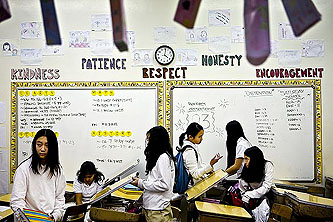 The LA Times has an interesting read today about the American Indian Public Charter schools in Oakland, which are some of the highest performing schools in the state of California:
The LA Times has an interesting read today about the American Indian Public Charter schools in Oakland, which are some of the highest performing schools in the state of California:
Not many schools in California recruit teachers with language like this: “We are looking for hard working people who believe in free market capitalism. . . . Multicultural specialists, ultra liberal zealots and college-tainted oppression liberators need not apply.”
….The Academic Performance Index, the central measuring tool for California schools, rates schools on a scale from zero to 1,000, based on standardized test scores. The state target is an API of 800….The oldest of the American Indian schools, the middle school known simply as American Indian Public Charter School, has an API of 967. Its two siblings — American Indian Public Charter School II (also a middle school) and American Indian Public High School — are not far behind.
….On Tuesday, American Indian’s high school will graduate its first senior class. All 18 students plan to attend college in the fall, 10 at various UC campuses, one at MIT and one at Cornell.
….The school could not provide its students’ elementary school test scores, so it is hard to say if they were [already above average when they were admitted]. Roberts did provide three years of middle school scores for all students who entered American Indian in 2004 (with names removed for privacy), showing their progress in math and English from sixth to eighth grade. Of the 51 students who entered American Indian’s middle school that year, only six scored lower than “proficient” in both math and English at the end of sixth grade.
In a nutshell, this story explains pretty well why I like charter schools — and also why I doubt they’re any kind of educational panacea. Lefty-baiting aside, AIPC is a super-strict, teach-to-the-test, no goofing off kind of place that apparently gets good results. So I say: fine. If there are some parents who want their kids to go to schools like this, let ’em.
At the same time, AIPC is tiny: 51 students in middle school and 18 in its first graduating class. It plainly attracts only parents and children who are academically motivated in the first place. It requires middle school teachers to teach every subject and keeps them on a grueling pace, which means lots of turnover. Cheerleaders to the contrary (“They really should be the model for public education in the state of California,” says Debra England of the Koret Foundation), the odds that the AIPC formula is scalable to an entire school district is nil.
It makes sense to try out different kinds of schools for different kinds of kids and different kinds of neighborhoods. With a few obvious caveats, I’m all for it. But let’s not pretend that any particular one of these charters is necessarily the model for everyone else on the basis of 18 cherry-picked graduates. It ain’t so.













